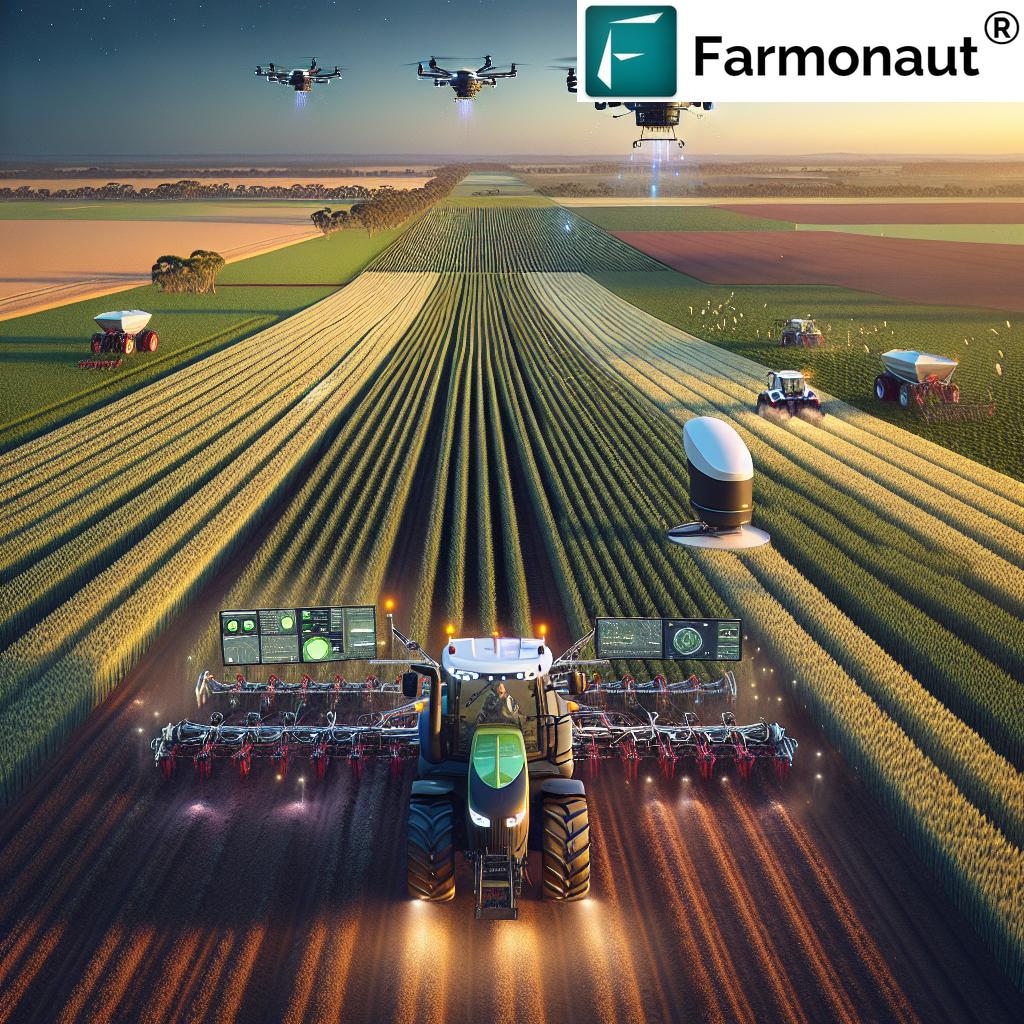Ultimate Guide: Boost Your Australian Dairy Farm Profitability with Smart Management Strategies in 2024
“Australian dairy farms implementing advanced irrigation systems can reduce water usage by up to 30% while maintaining productivity.”
Welcome to our comprehensive guide on maximizing profitability for Australian dairy farms in 2024. As we navigate the ever-evolving landscape of the Australian dairy industry, it’s crucial to stay ahead of the curve with smart management strategies. In this blog post, we’ll explore cutting-edge techniques for sustainable dairy farming, from optimizing milk production to implementing state-of-the-art irrigation systems.
Whether you’re managing a farm in the lush pastures of Victoria or the subtropical regions of Queensland, we’ve got you covered with invaluable insights on enhancing pasture management, improving herd health and welfare, and adopting environmentally friendly practices. Let’s dive into the world of modern dairy farm management and discover how you can boost your farm’s profitability in 2024 and beyond.

The Evolution of Dairy Farming in Australia
Before we delve into the strategies for 2024, let’s take a moment to appreciate how far the Australian dairy industry has come. From traditional family-run farms to modern, technology-driven operations, the sector has undergone a significant transformation. Today, dairy farming in Australia is not just about milking cows; it’s about smart resource management, data-driven decision-making, and sustainable practices that ensure long-term profitability.
In regions like Gippsland, New South Wales, and the Riverina, we’ve seen a shift towards more efficient farming methods. This evolution has been driven by a need to adapt to changing climate conditions, market demands, and economic pressures. As we look towards 2024, it’s clear that embracing innovation will be key to success in the Australian dairy industry.
Optimizing Milk Production: The Heart of Dairy Profitability
At the core of every successful dairy farm is efficient milk production. In 2024, we’re seeing a range of strategies to boost both quantity and quality:
- Advanced Breeding Programs: Utilizing genetics to improve herd productivity and resilience.
- Precision Feeding: Tailoring nutrition plans to individual cow needs for optimal milk output.
- Automated Milking Systems: Implementing robotic milking to increase efficiency and reduce labor costs.
- Health Monitoring Technology: Using wearable devices to track cow health and detect issues early.
By focusing on these areas, Australian dairy farms can significantly increase their milk yield while maintaining high-quality standards. This is particularly important in regions like Victoria, which accounts for a substantial portion of the country’s dairy production.
Sustainable Pasture Management: The Foundation of Dairy Farming
Pasture management is a critical aspect of dairy farming, especially in Australia’s diverse climate zones. From the temperate regions of Tasmania to the subtropical areas of Queensland, effective pasture strategies can make a significant difference in farm productivity and profitability.
- Rotational Grazing: Implementing smart grazing systems to maximize pasture utilization and recovery.
- Soil Health Management: Regular soil testing and targeted fertilization to improve pasture quality.
- Drought-Resistant Varieties: Introducing resilient grass species to withstand variable climate conditions.
- Precision Agriculture: Using satellite imaging and drones for accurate pasture assessment and management.
In 2024, we’re seeing an increased adoption of technology in pasture management. Platforms like Farmonaut offer satellite-based solutions for real-time crop health monitoring, helping dairy farmers make informed decisions about their pastures.

Water Management: A Critical Factor in Australian Dairy Farming
In a country where water scarcity is a persistent challenge, effective water management is crucial for dairy farm profitability. Here are some strategies we’re recommending for 2024:
- Advanced Irrigation Systems: Implementing precision irrigation to reduce water waste.
- Water Recycling: Treating and reusing dairy shed effluent for irrigation.
- Rainwater Harvesting: Installing systems to capture and store rainwater for farm use.
- Drought-Tolerant Crops: Introducing water-efficient feed crops to reduce irrigation needs.
For dairy farms in regions like the Murray-Darling Basin, where water allocation is a critical issue, these strategies can lead to significant cost savings and improved sustainability.
Climate Adaptation: Preparing for the Future
Climate change poses significant challenges to dairy farming in Australia. In 2024, successful farms are those that have implemented robust climate adaptation strategies:
- Heat Stress Management: Installing shade structures and cooling systems to protect cattle during extreme heat.
- Diversification: Introducing alternative income streams to mitigate climate-related risks.
- Carbon Footprint Reduction: Implementing practices to reduce greenhouse gas emissions and improve farm sustainability.
- Weather Forecasting Technology: Utilizing advanced weather prediction tools for better farm planning.
These strategies are particularly crucial for farms in regions like Far North Queensland and Western Australia, where climate variability can have a significant impact on dairy operations.
Herd Health and Welfare: The Key to Sustainable Production
Maintaining optimal herd health and welfare is essential for long-term profitability in dairy farming. In 2024, we’re seeing an increased focus on:
- Preventive Healthcare: Implementing comprehensive vaccination and disease prevention programs.
- Nutrition Management: Tailoring feed supplements to meet specific nutritional needs of the herd.
- Comfortable Housing: Designing cow-friendly facilities to reduce stress and improve productivity.
- Fertility Management: Using advanced reproductive technologies to improve breeding outcomes.
By prioritizing animal welfare, dairy farms not only improve their productivity but also align with consumer expectations for ethically produced dairy products.
“The Australian dairy industry contributes approximately $4.4 billion annually to the national economy, with Victoria producing 64% of the country’s milk.”
Technology Integration: The Future of Dairy Farming
In 2024, technology integration is no longer optional for successful dairy farming. Here are some key areas where technology is making a significant impact:
- IoT Sensors: Monitoring cow health, milk quality, and environmental conditions in real-time.
- Data Analytics: Using big data to make informed decisions on farm management.
- Robotics: Automating tasks like feeding and cleaning to improve efficiency.
- Blockchain: Enhancing traceability and transparency in the dairy supply chain.
Platforms like Farmonaut are at the forefront of this technological revolution, offering advanced solutions for crop monitoring and farm management. Their API and developer documentation provide valuable resources for integrating cutting-edge technology into dairy farm operations.


Financial Management and Risk Mitigation
Effective financial management is crucial for dairy farm profitability. In 2024, successful farms are focusing on:
- Diversified Income Streams: Exploring opportunities like agritourism or value-added products.
- Risk Management Strategies: Implementing insurance and hedging strategies to protect against market volatility.
- Government Grant Utilization: Leveraging available support programs for farm improvements and sustainability initiatives.
- Efficient Budgeting: Using advanced financial tools for accurate forecasting and cash flow management.
By adopting these financial strategies, dairy farms across Australia, from South Australia to New South Wales, can better navigate economic challenges and build resilience.
Environmental Sustainability: A Key to Long-Term Success
Environmental sustainability is no longer just a buzzword; it’s a critical component of successful dairy farming in 2024. Here’s how Australian dairy farms are becoming more environmentally friendly:
- Renewable Energy Adoption: Installing solar panels and biodigesters to reduce reliance on fossil fuels.
- Waste Management: Implementing advanced effluent management systems to minimize environmental impact.
- Biodiversity Conservation: Creating wildlife corridors and protecting native vegetation on farm properties.
- Carbon Sequestration: Adopting practices that increase soil carbon and reduce greenhouse gas emissions.
These practices not only benefit the environment but also often lead to cost savings and improved farm efficiency, particularly in regions like Tasmania and South West Western Australia, known for their unique ecosystems.
Market Positioning and Product Diversification
In an increasingly competitive market, successful dairy farms in 2024 are focusing on strategic market positioning and product diversification:
- Niche Market Targeting: Developing specialty dairy products for specific consumer segments.
- Value-Added Processing: Investing in on-farm processing to create higher-value products like artisanal cheeses or yogurts.
- Direct-to-Consumer Sales: Establishing farm shops or online platforms to sell directly to consumers.
- Export Market Expansion: Exploring opportunities in international markets, particularly in Asia.
By diversifying their product offerings and exploring new markets, dairy farms can reduce their dependence on traditional milk sales and increase overall profitability.

Workforce Development and Training
As dairy farming becomes more technologically advanced, investing in workforce development is crucial. In 2024, successful farms are prioritizing:
- Continuous Education: Providing regular training on new farming technologies and best practices.
- Skills Diversification: Encouraging staff to develop a broad range of skills, from animal husbandry to data analysis.
- Succession Planning: Developing strategies to attract and retain the next generation of dairy farmers.
- Work-Life Balance: Implementing policies that improve job satisfaction and retention in the dairy industry.
By investing in their workforce, dairy farms can ensure they have the skilled labor needed to implement advanced management strategies and technologies.
Comparison of Traditional and Modern Dairy Farm Management Strategies
| Management Area | Traditional Approach | Modern Strategy | Potential Impact on Profitability |
|---|---|---|---|
| Pasture Management | Fixed grazing patterns | Rotational grazing with satellite monitoring | Up to 20% increase in pasture utilization |
| Herd Health | Reactive treatment of illnesses | Preventive care with wearable health monitors | 15-25% reduction in health-related costs |
| Water Conservation | Basic irrigation systems | Precision irrigation with soil moisture sensors | Up to 30% reduction in water usage |
| Climate Adaptation | Limited climate control measures | Advanced cooling systems and heat-tolerant breeds | 10-15% increase in summer milk production |
| Technology Integration | Minimal use of farm technology | IoT sensors, robotics, and data analytics | 20-30% improvement in overall farm efficiency |
| Market Positioning | Focus on bulk milk production | Diversified product range and niche market targeting | Up to 25% increase in revenue per liter of milk |
Conclusion: Embracing the Future of Australian Dairy Farming
As we look towards 2024 and beyond, it’s clear that the Australian dairy industry is at a pivotal point. By embracing smart management strategies, from advanced technology integration to sustainable environmental practices, dairy farms across the country have the opportunity to significantly boost their profitability and ensure long-term success.
Whether you’re managing a small family farm in Tasmania or overseeing a large operation in the Riverina, the key to success lies in adaptability, innovation, and a commitment to sustainable practices. By implementing the strategies outlined in this guide, you can position your dairy farm at the forefront of the industry, ready to meet the challenges and opportunities of the future.
Remember, the journey to increased profitability is ongoing. Stay informed about industry developments, continue to invest in your farm’s infrastructure and your team’s skills, and don’t hesitate to leverage the power of technology to drive your farm’s success.
Frequently Asked Questions
- Q: How can I improve water efficiency on my dairy farm?
A: Implement precision irrigation systems, recycle dairy shed effluent, and consider drought-resistant pasture varieties. Technologies like Farmonaut can help monitor soil moisture levels for optimal water management. - Q: What are the best strategies for reducing heat stress in dairy cows?
A: Install shade structures, implement cooling systems like sprinklers and fans, ensure access to clean, cool water, and consider breeding for heat-tolerant traits. - Q: How can technology improve my dairy farm’s profitability?
A: Utilize IoT sensors for real-time monitoring of cow health and milk quality, implement data analytics for informed decision-making, and consider automated systems for tasks like milking and feeding. - Q: What government grants are available for Australian dairy farmers in 2024?
A: Check with your local agricultural department for the latest grant programs. Common areas for funding include water efficiency improvements, sustainable farming practices, and technology adoption. - Q: How can I diversify my dairy farm’s income streams?
A: Consider value-added products like artisanal cheeses, explore agritourism opportunities, or look into direct-to-consumer sales channels. You might also explore carbon credit opportunities through sustainable farming practices.
By implementing these strategies and staying informed about the latest developments in dairy farm management, you can position your Australian dairy farm for success in 2024 and beyond. Remember, profitability in dairy farming comes from a combination of efficient operations, sustainable practices, and smart market positioning. Stay adaptable, embrace innovation, and your dairy farm will thrive in the changing agricultural landscape.













